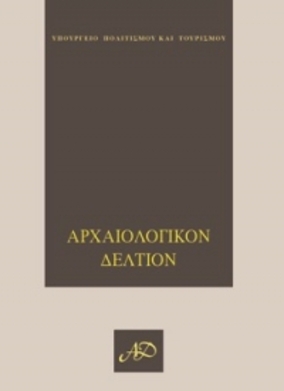Ιπποσκευές από τη Βεργίνα
Part of : Αρχαιολογικόν δελτίον ; Vol.41, 1986, pages 1-58
Issue:
Pages:
1-58
Parallel Title:
Harnesses from Vergina
Author:
Abstract:
The harnesses described here came from the Macedonian Tomb II in the Great Tumulus at Vergina. Some of them —bits, remains of bridles, a spur— were found in the chamber (PI. 1), and the rest —an intact bit, many iron plates and a spur— were found above the vault of the tomb. All these objects had originally been placed on the pyre in which the corpse was cremated. In addition to the above, horses’ teeth were also found on top of the vault. I. BRIDLES1. Phalara (Figs 1-3; PI. 1). These were four almost identical bronze bosses, each bearing an eight-petalled rosette. They were attached at points where the straps crossed: two at the level of the horse’s cheeks and the other two slightly higher than the mouth; they served to secure the leather strabs of the bridle and keep them in the correct position. 2. Remains of bridles (Figs 4-5; Pis 2-3). Small pieces of strabs were found with iron nails projecting from them. 17 such nails were found altogether, in two sizes, as well as 6 identical bronze nails with remnants of burnt leather. I calculate that these remains come from two bridles equipped with nails at certain points. 3. Metal fittings (Figs 6-16; Pis 4-8). These consist chiefly of strips of iron sheet that must have covered the straps of the bridles. They have two U-shaped arms whose flattened ends are oval, triangular, foliate or round in shape.II. BITS. Altogether one complete bit, the greater part of another and fragments of two more were found. They are all of iron and show strong signs of burning.1. Complete bit (Fig. 17; PL 9 a). Overall height: 0.192 m. The individual parts of the bit are held together by two axles that are joined in the middle of the mouth. Each axle consists of a bar whose inner end terminates in a large link of rectangular section, and the outer end in a conical button-shape. On the axles are mounted the other components of the bit: the disks, cylinders, and rings (links). These can all move and revolve independently of the axles. 2. Parts of a bit (Figs 18-19; Pis 9 β-11). These are parts of a bit that resembles the previous one, but with certain differences. 3. Parts of bits (Fig. 20; Pis 9 β-12 a). hi. spurs (Fig. 21; PI. 12 β-γ).A pair of bronze spurs was found. The few horse remains preserved on top of the vault of the tomb testify to the practise of sacrificing horses on the funeral pyre in honour of the deceased. It was an old custom known to us from Homer, according to whom four horses were burnt on the pyre of the dead Patroclus. To judge from the number of bits, four horses must also have been sacrificed on the cremation of the deceased man at Vergina.The harnesses can be dated to the 2nd half of the 4th c. BC, and the workshop where they were made should be looked for in the Macedonian area, at Pella or Amphipolis. These finds at Vergina are important for several reasons: 1) For the first time in Greece a large group of horse fittings dated by excavation evidence is known to us; 2) a new type of bit, hither to unknown, has been uncovered; 3) two new types of bridle have been recorded, one with toothed nails and the other reinforced with iron plates; 4) a new type of spur has been recorded; 5) for the first time in Greece horse sacrifices on a funeral pyre and the continuation of an ancient custom into the 4th c. BC have been attested.
Subject:
Subject (LC):
Notes:
Ο αρθρογράφοες ευχαριστεί τον καθηγητή Μ. Ανδρόνικο για την ανάθεση της μελέτης και της δημοσίευσης των ιπποσκευώντης Βεργίνας. Ευχαριστίες επίσης οφείλει και στους συνάδελφους Φιλ. Χατζή, Μπ. Σμιτ-Δούνα, Κ.Πιλάλη-Παπαστερίου και στη Διευθύντρια του Αρχαιολογικού Μουσείου Θεσσαλονίκης I. Βοκοτοπούλου, για τη βοήθειά τους σε επιμέρους προβλήματα, καθώς και στη ζωγράφο Ασπ. Φάκλαρη για τα επιμελημένα σχέδια της εργασίας., Περιέχει 30 σχέδια. Πίνακες 1-12 βλέπε τέλος τεύχους, Το άρθρο περιέχεται στο τεύχος: Μέρος Α'-Μελέτες




